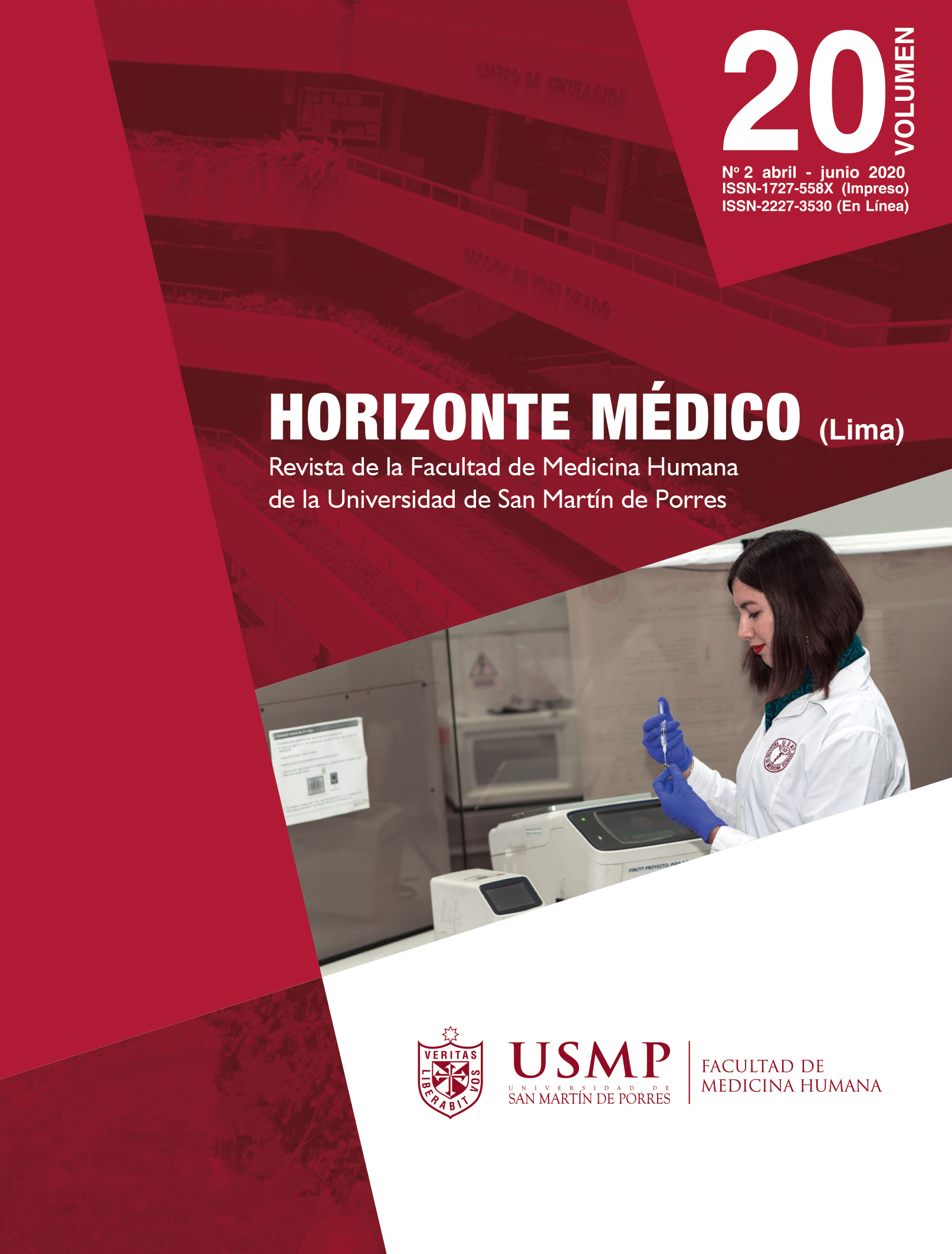Diagnostic tests for COVID-19: The importance of the before and the after
DOI:
https://doi.org/10.24265/horizmed.2020.v20n2.14Keywords:
Coronavirus infections, Diagnosis, RT-PCRAbstract
In 2019, in the city of Wuhan, China, patients were diagnosed with a novel coronavirus originally named 2019-nCoV, currently known as SARS-CoV-2. The alarming expansion of this pandemic makes it necessary to find out and implement reliable diagnostic methods in order to properly detect and treat patients, thus contributing to slowing down the spread of the disease. It is extremely important to have trained professionals in sample collection, good clinical laboratory practices, and molecular and hematological techniques to adequately detect any cases of infection with this virus. Moreover, standardized protocols are essential for obtaining, transferring and storing samples to stop the spread of the COVID-19 pandemic caused by SARS-CoV-2.
Downloads
References
World Health Organization. Novel Coronavirus (2019-nCoV)Situation reports. 2020. Disponible en: https://www.who.int/emergencies/diseases/novel-coronavirus-2019/situation-reports.
GenBank. Severe acute respiratory syndrome coronavirus 2 isolate Wuhan-Hu-1, complete genome. GenBank. 2020.
Li C, Yang Y, Ren L. Genetic evolution analysis of 2019 novel coronavirus and coronavirus from other species. Infect Genet Evol. 2020; 82: 104285.
Ji W, Wang W, Zhao X, Zai J, Li X. Cross-species transmission of the newly identified coronavirus 2019-nCoV. J Med Virol. 2020; 92(4): 433-40.
Lu R, Zhao X, Li J, Niu P, Yang B, Wu H, et al. Genomic characterization and epidemiology of 2019 novel coronavirus: implications for virus origins and receptor binding. Lancet. 2020; 395(10224): 565-74.
Coronaviridae Study Group of the International Committee on Taxonomy of Viruses. The species severe acute respiratory syndrome-related coronavirus: classifying 2019-nCoV and naming it SARS-CoV-2. Nat Microbiol 2020; 5(2020): 536-44.
Lippi G, Plebani M, Graber ML. Building a bridge to safe diagnosis in health care: the role of the clinical laboratory. Clin Chem Lab Med. 2016; 54: 1-3.
Peiris JS, Yuen KY, Osterhaus AD, Stöhr K. The severe acute respiratory syndrome. N Engl J Med. 2003; 349(25): 2431-41.
Wu C, Liu Y, Yang Y, Zhang P, Zhong W, Wang Y, et al. Analysis of therapeutic targets for SARS- CoV-2 and discovery of potential drogs by computational methods. Acta Pharm Sin B. 2020.
Enjuanes L, Almazan F, Sola I, Zuniga S. Biochemical aspects of coronavirus replication and virus-host interaction. Annu Rev Microbiol. 2006; 60: 211-30.
Belouzard S, Millet JK, Licitra BN, Whittaker GR. Mechanisms of coronavirus cell entry mediated by the viral spike protein. Viruses. 2012; 4: 1011-33.
Walls AC, Park Y, Tortorici MA, Wall A, McGuire AT, Veesler D. Structure, function, and antigenicity of the SARS-CoV-2 spike glycoprotein. Cell. 2020.
Chan JF, Yuan S, Kok KH, To KK, Chu H, Yang J, et al. A familial cluster of pneumonia associated with the 2019 a study of a family cluster. Lancet. 2020; 395(10223): 514-23.
Zhou P, Yang XL, Wang XG, Hu B, Zhang L, Zhang W, et al. A pneumonia outbreak associated with a new coronavirus of probable bat origin. Nature. 2020; 579(7798): 270-3.
Liu R, Han H, Liu F, Lv Z, Wu K, Liu Y, et al. Positive rate of RT-PCR detection of SARS-CoV-2 infection in 4880 cases from one hospital in Wuhan, China, from Jan to Feb 2020. Clin Chim Acta. 2020; 505: 172-5.
Corman VM, Landt O, Kaiser M, Molenkamp R, Meijer A, Chu D, et al. Detection of 2019 novel coronavirus (2019-nCoV) by real-time RT-PCR. Euro Surveill. 2020; 25(3): 2000045.
Corman VM, Müller MA, Costabel U, Timm J, Binger T, Meyer B, et al. Assays for laboratory confirmation of Novel human Coronavirus (hCoV-EMC) Infections. Euro Surveill. 2012; 17(49).
Lippi G, Simundic AM, Plebani M. Potential preanalytical and analytical vulnerabilities in the laboratory diagnosis of coronavirus disease 2019 (COVID-19). Clin Chem Lab Med. 2020.
Ai T, Yang Z, Hou H, Zhan C, Chen C, Lv W, et al. Correlation of chest CT and RT-PCR testing in coronavirus disease 2019 (COVID19) in China: a report of 1014 cases. Radiology. 2020: 200642.
Long C, Xu H, Shen Q, Zhang X, Fan B, Wang C, et al. Diagnosis of the coronavirus disease (COVID-19): rRT-PCR or CT?. Eur J Radiol. 2020; 126: 108961.
Shen Z, Xiao Y, Kang L, Ma W, Shi L, Zhang L, et al. Genomic diversity of SARS-CoV-2 in coronavirus disease 2019 patients. Clin Infect Dis. 2020.
Prompetchara E, Ketloy C, Palaga T. Immune responses in COVID-19 and potential vaccines: lessons learned from SARS and MERS epidemic. Asian Pac J Allergy Immunol. 2020; 38(1): 1-9.
Li G, Fan Y, Lai Y, Han T, Li Z, Zhou P, et.al. Coronavirus infections and immune responses. J Med Virol. 2020; 92(4): 424-32.
Dong X, Cao Y, Lu X, Zhang J, Du H, Yan Y, et al. Eleven faces of coronavirus disease 2019. Allergy. 2020.
Zhao J, Yuan Q, Wang H, Liu W, Liao X, Su Y, et al. Antibody responses to SARS-CoV-2 in patients of novel coronavirus disease 2019. Clin Infect Dis. 2020.
Irving SA, Vandermause MF, Shay DK, Belongia EA. Comparison of nasal and nasopharyngeal swabs for influenza detection in adults. Clin Med Res. 2012; 10: 215-8.
Spencer S, Gaglani M, Naleway A, Reynolds S, Ball S, Bozeman S, et al. Consistency of influenza a virus detection test results across respiratory specimen collection methods using real-time reverse transcription-PCR. J Clin Microbiol. 2013; 51: 3880-2.
Espy MJ, Uhl JR, Sloan LM, Buckwalter SP, Jones MF, Vetter EA, et al. Real-time PCR in clinical microbiology: applications for routine laboratory testing. Clin Microbiol Rev. 2006; 19: 165-256.
Van Zyl G, Maritz J, Newman H, Preiser W. Lessons in diagnostic virology: expected and unexpected sources of error. Rev Med Virol. 2019; 29: e2052.
Centers for Disease Control and Prevention. Coronavirus Disease 2019 (COVID-19): Guidelines for Clinical Specimens. 2020. Disponible en: https://www.cdc.gov/coronavirus/2019-ncov/lab/guidelines-clinical-specimens.html
Published
How to Cite
Issue
Section
License
Copyright (c) 2020 Horizonte Médico (Lima)

This work is licensed under a Creative Commons Attribution 4.0 International License.
Horizonte Médico (Lima) (Horiz. Med.) journal’s research outputs are published free of charge and are freely available to download under the open access model, aimed at disseminating works and experiences developed in biomedical and public health areas, both nationally and internationally, and promoting research in the different fields of human medicine. All manuscripts accepted and published in the journal are distributed free of charge under the terms of a Creative Commons license – Attribution 4.0 International (CC BY 4.0).


















